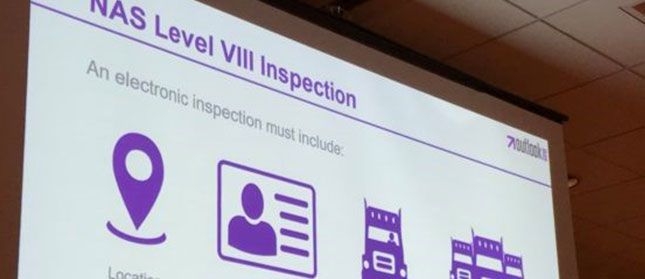
Electronic roadside inspections are moving closer to reality thanks to mandated electronic logging devices (ELDs) and inspection requirements defined by the Commercial Motor Vehicle Safety Alliance (CVSA), reports Today’s Trucking from the Omnitracs’ Outlook user conference in Nashville.
The weigh station bypass service – which supplies the technology behind Alberta’s Partners in Compliance program – hopes to be involved in a field trial of wireless roadside inspections by the end of the year, said Charles Buffone, senior product manager of Drivewyze. The plan is to target three to six U.S. locations at first.
Trial participants who are pulled in to a scale would be eligible for an expedited Level 3 CVSA inspection, since equipment would deliver the data to pre-populate inspection forms. Assuming that a driver’s hours of service are up to date and their CDL is valid, trucks could be sent on their way in five to 10 minutes rather than the traditional process that takes a half hour or more, Today’s Trucking reports.
“We did a demo of this in 2012 in Maryland, so we’ve been working on this for a long time,” Buffone said. But the mandated technology and clear definitions were missing.
“The ELD data can be used as a great leverage point for inspections,” he explained. “It sets you up for ubiquitous adoption.”
The CVSA, meanwhile, recently established the Level 8 inspection criteria that defines what such inspections must cover. Required details include locations; driver licences, endorsements, medicals, and hours of service; vehicle registration, UCR registration, and out-of-service data; and carrier U.S. DOT numbers.
The Federal Motor Carrier Safety Administration began working on a proof of concept for wireless roadside inspections as early as 2006, but last year the related funding came to an end because they were effectively competing with industry, Buffone said. “There really is no reason for the government to be investing in that level.”
Drivewyze itself is now connected to bypass programs in 700 locations and has a presence in 44 states and Alberta.
There are still questions about how such inspections would be conducted, Buffone said. The government could mandate the enforcement tool, but there are questions about the technologies regulators would choose, and how they would keep up with the pace of change. Also, how would they fund such a program? There are privacy issues for the data, too.
Perhaps most important of all, there are the questions about whether such a program would offer a reward for a passed inspection – similar to the bypass programs of today – or if the electronic inspection can actually be failed.
Read full story here.
